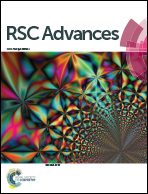Simplistic construction of cadmium sulfoselenide thin films via a hybrid chemical process for enhanced photoelectrochemical performance†
Abstract
We have successfully synthesized cadmium sulfoselenide (Cd(S1−xSex)) thin films via a simplistic and promising self-organized chemical growth process for photoelectrochemical (PEC) application. The effects of bath composition on the optical, structural, morphological, and electrical properties and the photoelectrochemical performance of (Cd(S1−xSex)) thin films have been investigated. Deposited thin films were characterized using UV-Vis spectrophotometry, X-ray diffraction (XRD), high-resolution transmission electron microscopy (HRTEM) with a selected area electron diffraction (SAED) pattern, field-emission scanning electron microscopy (FESEM) coupled with energy dispersive X-ray spectroscopy (EDS), X-ray photoelectron spectroscopy (XPS), electrical conductivity (EC) and thermoelectric power (TEP) measurement techniques. An optical absorption study showed that the maximum light absorption in the 630–720 nm wavelength range and the linear nature of absorption plots indicate that the transition is a direct allowed type. The optical band gap energy decreased from 2.13 to 1.71 eV with varying bath composition. The XRD study illustrated that deposited thin films are in the pure phase with a nanocrystalline nature. HRTEM images highlight the formation of clearly-defined, interconnected particle, which aggregated to form a well-grown custard apple-like morphology over the entire substrate and are in good accordance with FESEM micrographs. The SAED pattern shows a ring pattern indicating the nanocrystalline nature of the deposited thin film. The FESEM study demonstrated that the developed surface morphology is favorable for effectual light absorption in the solar spectrum. The XPS analysis specified the presence of Cd2+, S2− and Se2− elements in the deposited thin film. The EDS spectrum confirmed that thin film deposition occurs in a stoichiometric manner. From the EC measurement study, it was observed that electrical conductivity increases correspondingly for all thin films, indicating semiconducting behavior. TEP measurements established that Cd(S1−xSex) thin films are n-type in nature. Finally, the deposited thin films were tested for photoelectrochemical (PEC) application. The PEC study illustrated that (Cd(S0.2Se0.8)) thin film showed the highest power conversion efficiency (η) of 1.02% among reported values.


 Please wait while we load your content...
Please wait while we load your content...